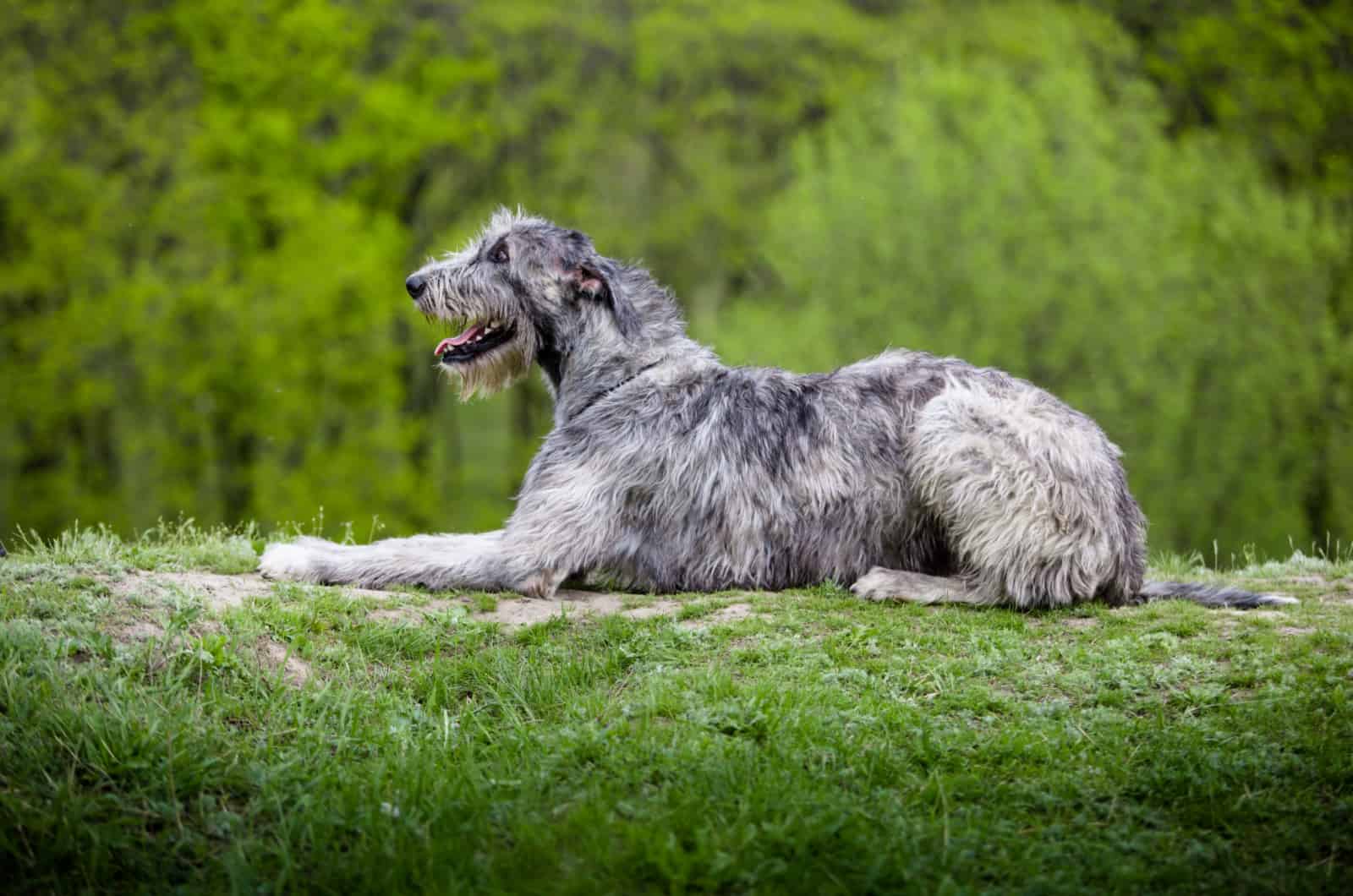The Irish Wolfhound, also called the Irish Greyhound, is the tallest dog breed accepted by the AKC (American Kennel Club). Not only are they the tallest, but they are also one of the heaviest dogs as well. For example, by around six months of age, the Irish Wolfhound puppy can weigh around 90 pounds!
The Irish Wolfhound is a large breed and it needs a lot of food. But, how much is enough, and what is appropriate at what age? When we have giant breed dogs at home to take care of, it can be confusing to work out what dog food they should eat and how much we should give them to eat.
But, with the Irish Wolfhound feeding chart done according to the life stages of your dog, you can easily see how much is alright to give.
From weaning time to senior years – we’ve got it all covered.
The Irish Wolfhound Feeding Chart
OK, the Irish Wolfhound is truly a magnificent dog breed. They have that beautiful calm and dignified aura around them. But, no matter how tame and gentle they look – they can eat a lot! Actually, Irish Greyhound puppies are one of the most rapidly growing puppies in the dog world.
When the growth is as rapid as in the Irish Wolfhound, we need to know what type of food to give these dogs, how often, and what can we expect during different life stages. Here is the Irish Wolfhound feeding chart to help you better understand the amount of food this dog breed needs as it grows, as well as during its adult and senior years of life.
[table id=625 /]
In general, 1 cup is around 120g or 4 ounces. This is the measure if you are feeding your dog dry dog food.
Feeding The Irish Wolfhound Through Different Life Stages
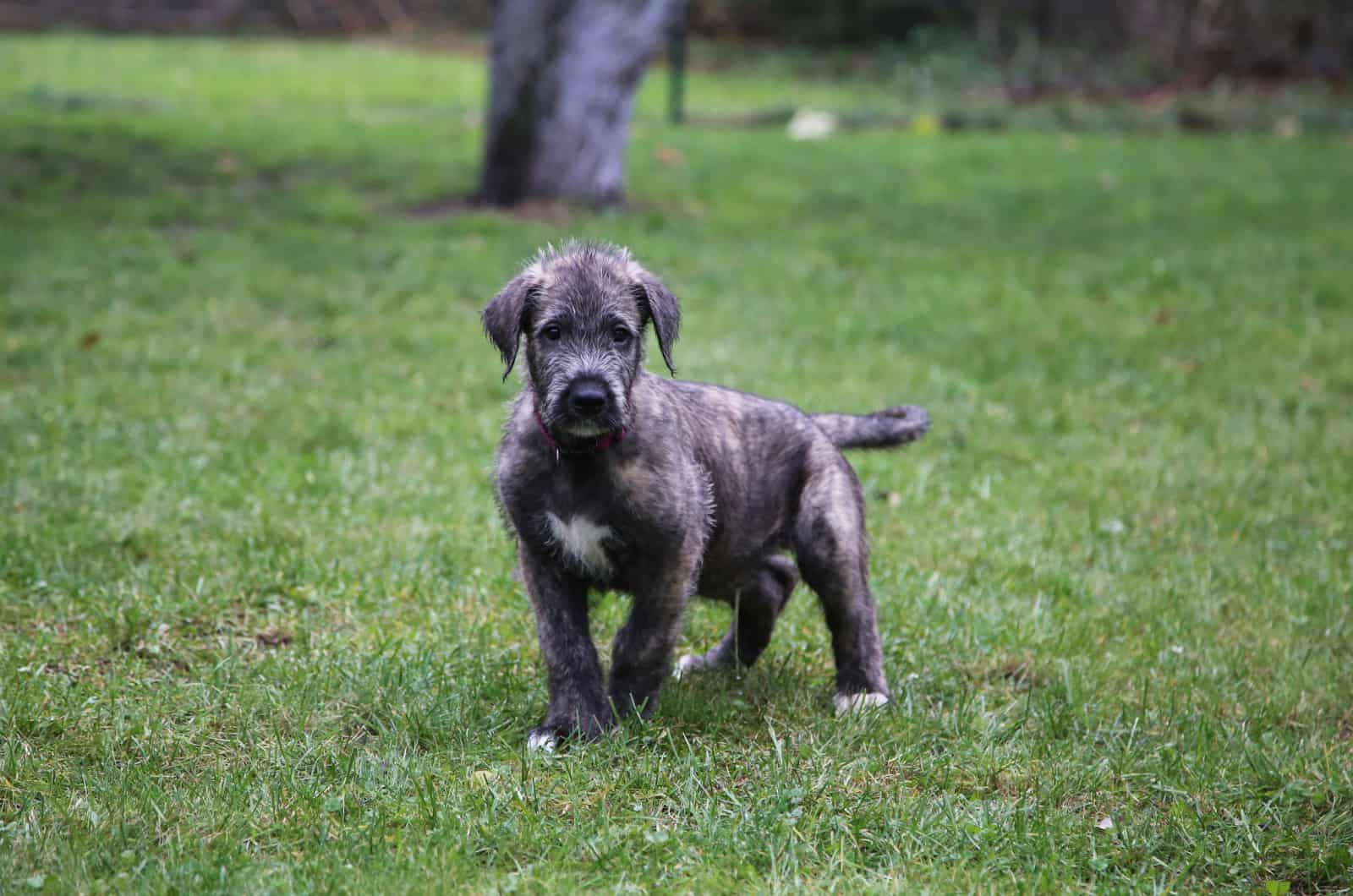
How often and how much we feed our dogs depends on a lot of things. The first thing is the age of our dog. The amount of food we give to our adult dogs and puppies is not the same. The difference between feeding a growing wolfhound and an adult one lies in the number of meals per day, as well.
Other factors we should take into consideration are the overall health of the dog, daily activity level, and if it’s a lactating or pregnant female dog. Of course, we are not mentioning the type of dog breed because we are only talking about the Irish Wolfhound.
The Irish Wolfhound is a large dog breed, bred a long time ago for hunting purposes. It’s a scenthound used to long hours chasing large game like deer or wolves. The adult male Irish Wolfhound can grow 32 inches tall minimum, and weigh up to 120 pounds. Females are slightly smaller in weight and height.
As you can see, these are quite large dogs that need a lot of food. For example, some other hound dogs or other breeds of dogs in their adult years, like Basset Hounds, need around 16 ounces of food per day. If the dog is more active it will need more food.
It is the most recommended type of food by various pet food manufacturers, but by veterinarians around the world as well. The other name for dry food is kibble, and it is the most common type of food included in a large or small dog’s diet.
We will talk about types of food and diets for an adult Wolfhound later, but for now, let’s dive deeper into the Irish Wolfhound feeding chart by months of age.
2-3 Months
The only source of nutrients for puppies for the first 3 to 4 weeks after birth is their mother’s milk. They get all the necessary vitamins, minerals, and proteins through breastfeeding. But, after 2 months the weaning process can start.
The weaning process means starting to add solid food to their diet. You have to be patient during this transition. But, eventually, puppies will follow their instincts and do what their mom does. So, at this age, 5 to 13 ounces per day is a good daily amount of solid food.
You should also free-feed the puppies; that means there is no precise number of meals. Instead, you leave the bowl with food for them to nibble on whenever they feel like it. The reason this is an appropriate feeding method lies in the fact that the puppies are just starting to learn how to eat solid pet food. Giving them the opportunity to try it out when they want to makes the transition easier.
The transition can be faster if you make a puppy mush. Puppy mush means adding water or milk to kibble to make it softer and more appropriate for the puppy’s teeth and way of eating.
It is important to give them food that is made for puppies and labeled as such. Puppy food has all the ingredients to support the immune system of a puppy body that is rapidly developing and growing.
4-5 Months
The time of rapid growth is most noticeable after 4 months of age. Puppies enter the stage in their life when they require more ounces a day. So, around this time, we should feed the puppies 14 to 20 ounces a day, within 3 to 4 meals a day.
Separating food we give our dogs into numerous meals during the day helps the dogs with obedience and lowers the risk of obesity, as well as some other health problems that can occur, especially later in life.
The food needs to be high-quality, that is high in proteins and low in carbohydrates. It should also have all the supplements to help the growth of a dog. That includes minerals, vitamins, calcium, phosphorus, antioxidants, etc. In general, food made for rapidly developing puppies should support the growing organism and ensure the overall well-being of a dog.
We can start feeding raw food to puppies, too. Before introducing raw feeding, you should always consult your veterinarian first.
6-8 Months
This is the adolescence period of your dog, which means adding more food to the table. The recommended daily amount of food for puppies between 6 and 8 months of age is 22 to 31 ounces, separated into three meals a day.
When we say adolescence period, we mean it. Get ready to “remind” your puppy of all the feeding manners they already learned. If the puppies exhibit any signs of aggression when they are eating, make sure to end such behavior immediately.
This change in behavior is normal during this time because of the higher levels of sex hormones, and their fluctuation. But, if you stop it in time, you won’t have problems later.
Adolescence in dogs means they are much more active. They are still developing, especially puppies of large dog breeds. Smaller dog breeds mature around 9 months of age. But, our Irish Wolfhound puppies still have time to grow.
Even though Irish Wolfhounds are not as active as some other breeds, they need long walks during this period. Longer walks mean more energy spent that needs to be compensated through the proper Irish Wolfhound feeding chart.
That’s why, depending on the activity level of the puppy, we feed them more than 22 ounces per day, all the way up to 31 ounces.
9-12 Months
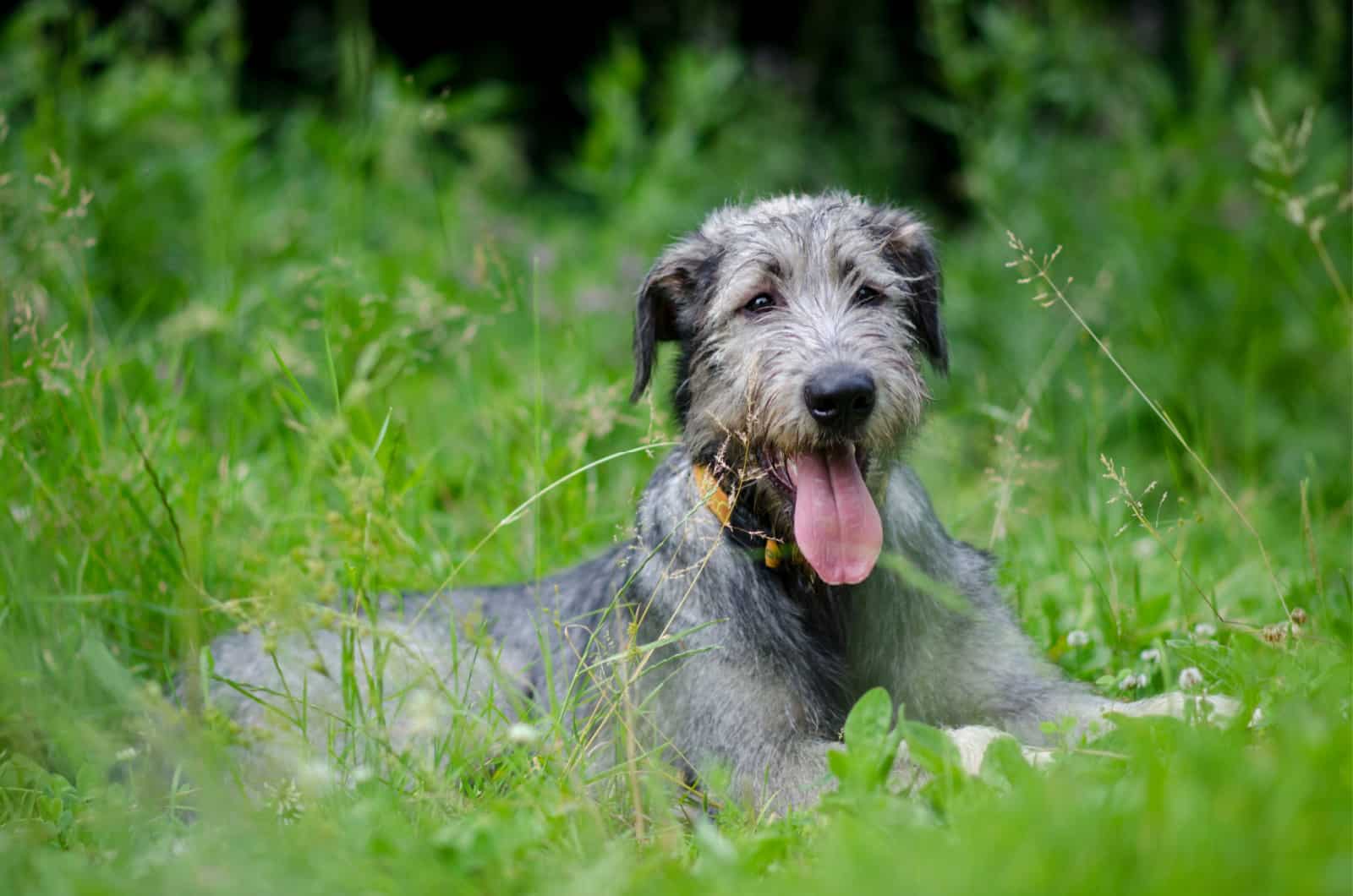
The teenagers’ hormones rampage is slowing down, and when they reach 12 months of age, puppies are no longer considered puppies, but adult dogs.
Even though they are getting calmer and getting to the weight and height of their adult version, they still need food intended for puppies. This is the perfect time to fully introduce them to raw meat and raw diets.
You can talk to your veterinarian about the appropriate raw natural diet that is the most suitable one for your dog. After you make the decision that you are going to transition to a raw diet, you should check out the Irish Wolfhound feeding chart to make sure you are not overfeeding your dog.
Remember: one cup means 120 grams of kibble or 4 ounces. In general, a dog from 9 to 12 months of age should have 32 ounces of raw food a day, divided into 2 meals a day.
Overfeeding can lead to a dog being overweight which is proven to be connected to various health problems, such as heart disease, problems with the digestive system, etc. That’s why adding taurine to your dog’s diet is important to help prevent heart issues, vitamin C works as a booster of the immune system, etc.
Taking care of your dog’s food and the amount of food they eat is important when it comes to keeping your dog healthy and making sure your dog is of an appropriate body weight.
Adult Years
From 12 months of age all the way to the senior years, your dog should have a stable feeding system that doesn’t have a lot of changes. Dogs still need high-quality food – kibble or homemade.
You shouldn’t experiment with types of food. This means you should stick to one type of food that was proven to be the best for your doggo. Checking the Irish Wolfhound feeding chart, we can see that adult dogs need two meals and 21 to 25 ounces daily.
Even though the development has stopped and the Irish Wolfhound has reached its full height and weight, they still need food that has all the necessary ingredients to keep them healthy. Irish Wolfhounds can eat a lot, but that doesn’t mean they should.
Always divide their food according to the Irish Wolfhound feeding chart to ensure they are eating properly, without the risk of developing health problems, some of which can be very serious and even deadly: GDV (Gastric dilatation and volvulus) or commonly known as bloat.
Senior Years
The Irish Wolfhound is one of the dog breeds with the shortest lifespan. Their average lifespan is from 6 to 8 years. That means they enter their senior years faster than other dog breeds. You can start changing their diet and their daily activity levels when they enter the 5th year of their lives.
Following the Irish Wolfhound feeding chart, when they enter their senior years, we should feed them 22 to 24 ounces a day, still divided into 2 meals. During the dog’s senior years, it is important to give them a balanced diet consisting of proteins, fat, sodium, and phosphorus.
Consulting your vet about the supplements is also important for the senior dog. They need vitamins and minerals to keep them healthy and to prolong their life for as long as it is possible. After all, they are a part of our family.
But, unfortunately, the reason behind such a short lifespan in Irish Wolfhounds is that they are prone to heart diseases, bloat, and cancer. Often, we can’t predict or stop the development of some of these diseases, especially cancer. But, we can make sure they live the best lives possible, no matter whether they are with us for 6 years or 15 years.
What Is The Best Food To Feed An Irish Wolfhound?
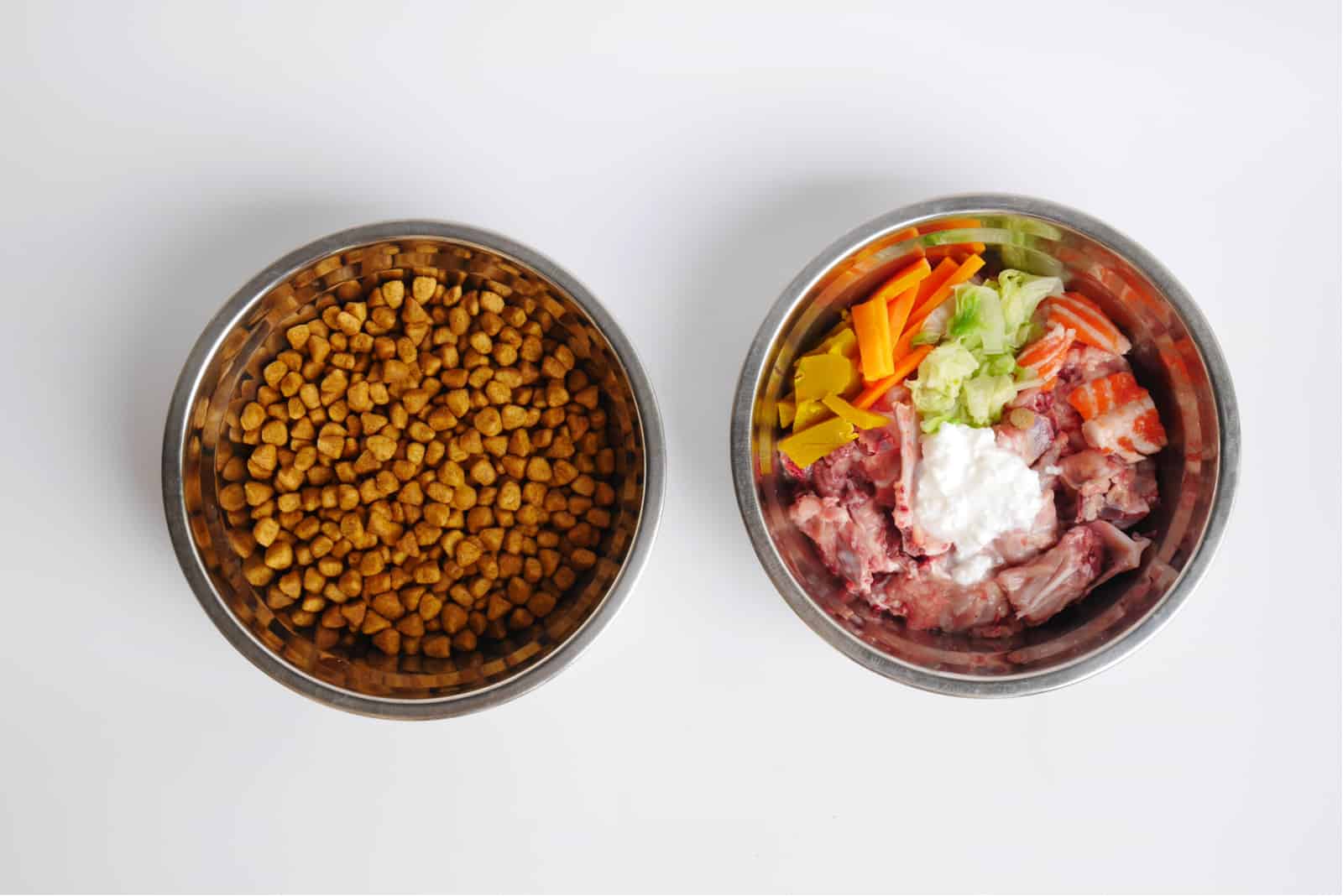
As in every field, there are debates about what food to feed your Irish Wolfhound, as well. Some breeders say the natural raw diet is the best, while others say we shouldn’t risk raw food because it can have pathogenic bacteria that can lead to serious health problems in a dog.
So, what is the best food to feed an Irish Wolfhound?
There are several options:
1. Dry food – kibble
2. Raw food – raw meaty bones
3. Cooked food – homemade cooked meat and veggies
If you ask veterinarians, they will have different opinions too. One thing they will agree on is that there is a risk of infection if we feed the dogs raw meat. But, that’s why we can cook the meat, and kill off the bacteria during the cooking process.
Others say splinters are the problem too. When we give raw meaty bones to our dogs, a bone splinter can get stuck in their throat, or esophagus, or even cause a rupture in the dog’s stomach if it passes the esophagus. That is a serious situation that can lead to death.
But, there is one thing that we can all agree on – feeding your dog according to the Irish Wolfhound feeding chart and with grain-free food is one of the best options. Most dry dog types of food have grain in them, which can cause intolerances in dogs that can be seen as allergy symptoms (red, itchy skin, ear inflammation, etc.) or as vomiting and/or diarrhea.
That’s why you should look for dry dog food that has a “grain-free” label or consult your veterinarian about what dry dog food you should give to your dog.
What Can Influence The Feeding Chart?
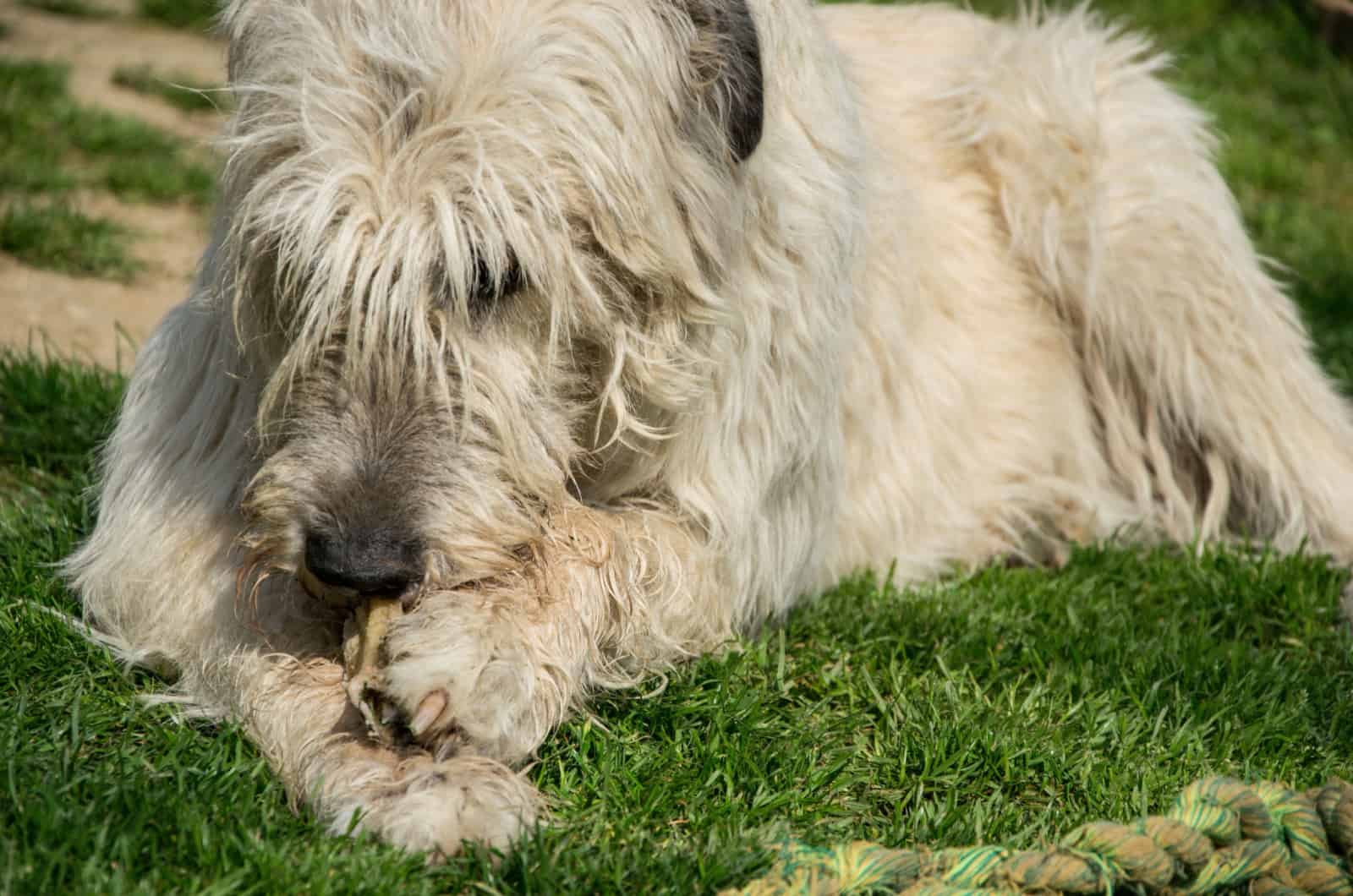
We have the Irish Wolfhound feeding chart according to the age of the dog. This is the most appropriate way of feeding the dog because the dog’s needs change during his lifetime. A puppy needs more daily meals with more minerals and vitamins to support the body’s growth.
An adult dog needs a balanced and stable diet that doesn’t change a lot and that has a high level of proteins and a low level of carbs. Senior dogs need fewer ounces a day, but more supplements to keep them healthy.
But, there are situations that can influence the feeding chart. Those situations are:
• Health
• Activity level
• Pregnancy
We have to change the Irish Wolfhound feeding chart if the dog has health problems. The chart will be changed according to the health problem and according to the instructions of the vet.
Activity level demands us to adjust the feeding in a way that we don’t cause our dog to become overweight. So, if your dog is a couch potato and you can’t make it go on a walk, you have to give them less food to avoid obesity. On the other hand, if they are very active and love to run around, the amount of food should be higher to satisfy their high energy levels.
Pregnancy also changes the feeding chart. The amount of food of a pregnant dog has to be higher than usual because she has puppies in her belly that need the proper amount of nutrients for them to develop.
If you have to change the Irish Wolfhound feeding chart because of some of these situations and you are not sure how to do it, the best solution is to ask a professional – a vet.
How To Feed An Irish Wolfhound To Prevent Bloat
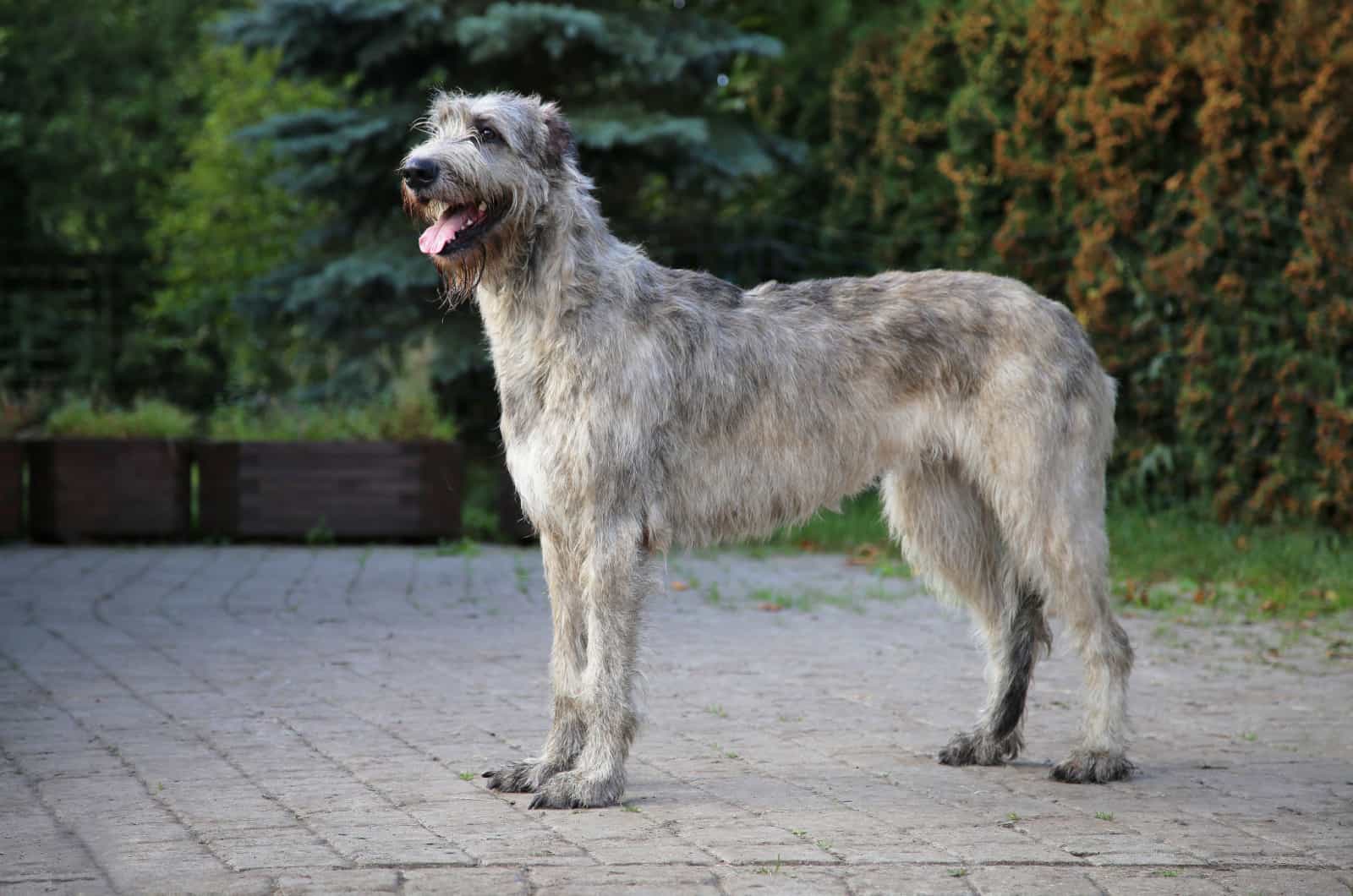
Besides feeding your Irish Greyhound according to the well-established Irish Wolfhound feeding chart, there are ways to feed your dog to prevent bloat.
Bloat or GDV is the most common health problem in large dogs. Bloat is a serious health problem that happens when the stomach of a dog fills with food, liquid, or air, twisting itself and pressing the surrounding organs at the same time.
Dogs that eat fast and one big meal a day are at risk of developing bloat. Also, large dog breeds with deep chests are more prone to bloat than other dog breeds.
What To Do?
• Do not free-feed your dog. Free feeding is only for puppies that are transitioning to a solid food diet
• Elevate your dog’s food and water bowls so that the dog doesn’t have to lean down to eat
• Do not feed your dog right after exercise – wait approximately 1 hour before feeding
• Do not let your dog do any type of exercise right after feeding – wait for 1 hour
In addition to these steps, some people soak the kibble in hot water and add supplements regularly to the dog’s diet to prevent bloat. These supplements can be natural, for example, vegetables like brussels sprouts, sweet potatoes, carrots, etc.
The Conclusion
The Irish Wolfhound feeding chart is developed according to the dog’s age. It covers the needs of a dog from 1 month of age to senior years. Different stages of a dog’s life need different amounts of food and meals per day.
There are different types of diets, too. But, whether you choose a raw diet or kibble to give to your dog, the outcome should be the same – keep your dog healthy and don’t let them get overweight. Also, avoid free-feeding your dog to avoid bloat.
All in all, dogs need high-quality food with supplements, and they need a routine to make sure they are healthy. A routine is giving them food two times a day at approximately the same time. For example, in the morning and in the evening.
The Irish Wolfhound feeding chart is made to help your dog stay healthy and fit for the rest of its doggy life, and we hope it will be a long one.
